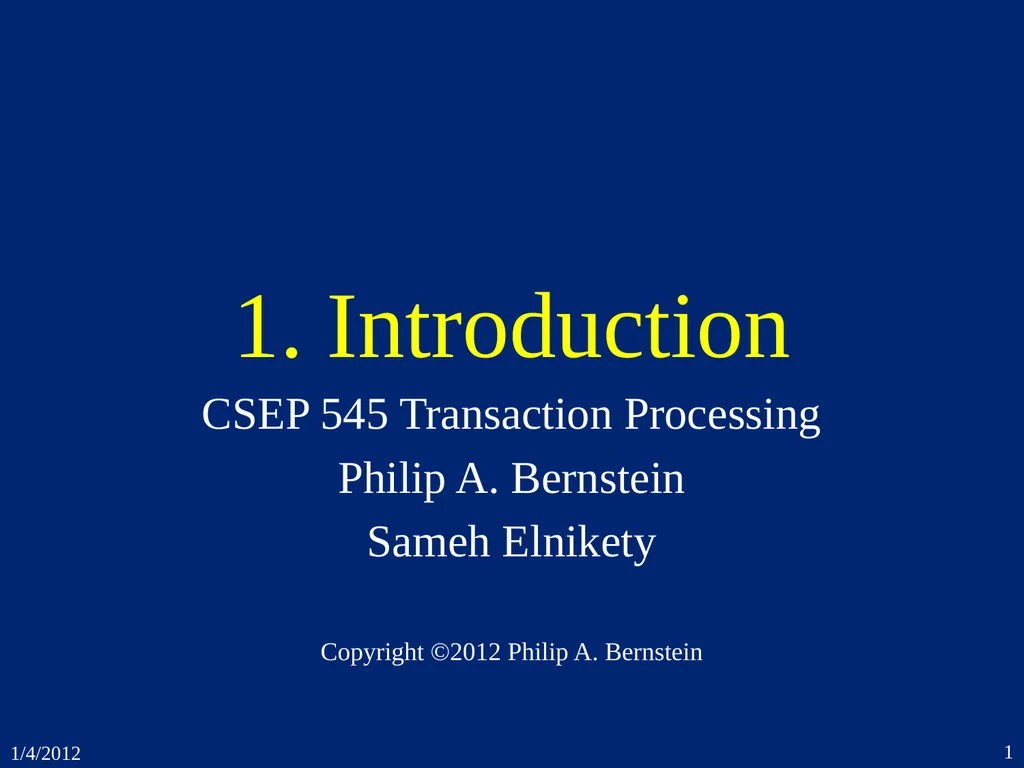1. Introduction CSEP 545 Transaction Processing
Author : debby-jeon | Published Date : 2025-05-19
Description: 1 Introduction CSEP 545 Transaction Processing Philip A Bernstein Sameh Elnikety Copyright 2012 Philip A Bernstein 142012 1 Outline 1 The Basics 2 ACID Properties 3 Atomicity and TwoPhase Commit 4 Performance 5 Scalability
Presentation Embed Code
Download Presentation
Download
Presentation The PPT/PDF document
"1. Introduction CSEP 545 Transaction Processing" is the property of its rightful owner.
Permission is granted to download and print the materials on this website for personal, non-commercial use only,
and to display it on your personal computer provided you do not modify the materials and that you retain all
copyright notices contained in the materials. By downloading content from our website, you accept the terms of
this agreement.
Transcript:1. Introduction CSEP 545 Transaction Processing:
1. Introduction CSEP 545 Transaction Processing Philip A. Bernstein Sameh Elnikety Copyright ©2012 Philip A. Bernstein 1/4/2012 1 Outline 1. The Basics 2. ACID Properties 3. Atomicity and Two-Phase Commit 4. Performance 5. Scalability 1/4/2012 2 1.1 The Basics - What’s a Transaction? The execution of a program that performs an administrative function by accessing a shared database, usually on behalf of an on-line user. Examples Reserve an airline seat. Buy an airline ticket. Withdraw money from an ATM. Verify a credit card sale. Order an item from an Internet retailer. Place a bid at an on-line auction. Submit a corporate purchase order. 1/4/2012 3 The “ities” are What Makes Transaction Processing (TP) Hard Reliability - system should rarely fail Availability - system must be up all the time Response time - within 1-2 seconds Throughput - thousands of transactions/second Scalability - start small, ramp up to Internet-scale Security – for confidentiality and high finance Configurability - for above requirements + low cost Atomicity - no partial results Durability - a transaction is a legal contract Distribution - of users and data 1/4/2012 4 What Makes TP Important? It’s at the core of electronic commerce Most medium-to-large businesses use TP for their production systems. The business can’t operate without it. It’s a huge slice of the computer system market. One of the largest applications of computers. 1/4/2012 5 TP System Infrastructure User’s viewpoint Enter a request from a browser or other display device The system performs some application-specific work, which includes database accesses Receive a reply (usually, but not always) The TP system ensures that each transaction Is an independent unit of work Executes exactly once Produces permanent results TP system makes it easy to program transactions TP system has tools to make it easy to manage 1/4/2012 6 TP System Infrastructure … Defines System and Application Structure Front End Program Request Controller (routes requests and supervises their execution) Database System Client Back-End (Server) End-User Transaction Server requests 1/4/2012 7 System Characteristics Typically < 100 transaction types per application Transaction size has high variance. Typically, 0-30 disk accesses 10K - 1M instructions executed 2-20 messages A large-scale example: airline reservations Hundreds of thousands of active display devices Indirect access via Internet Tens of thousands of transactions per second, peak 1/4/2012 8 Availability Fraction of time system is able to do useful work Some systems are very sensitive to downtime Airline














